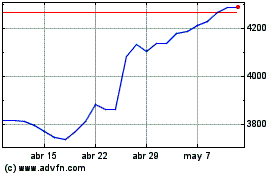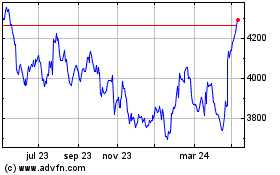Unilever Shows It Can Still Scrub Up Well -- Heard on the Street
23 Julio 2020 - 7:19AM
Noticias Dow Jones
By Carol Ryan
Unilever is playing a poor hand well. A big food-service
business and exposure to emerging markets will remain a problem,
but the company showed new strengths in its second quarter.
The maker of Dove soap and Hellman's mayonnaise said Thursday
that sales in the three months through June were roughly flat
compared with the same period of 2019, stripping out the impact of
currency and portfolio changes. That easily beat the 4.3% decline
that analysts covering the stock were expecting. Unilever's shares
jumped 8% in early trading, making it the biggest gainer in
London's blue chip FTSE 100 index.
Unilever met the strong demand for its food and hygiene products
as consumers do more cooking and cleaning at home. Sales of hand
sanitizer -- previously a minor part of its business -- grew more
than 20,000% in the quarter. In less than six months, Unilever's
hand-sanitizer business has grown larger than the market leader
last year.
Sales in North America increased 9.5% and Unilever is gaining
market share again in this important market. Free cash flow almost
doubled to EUR2.9 billion ($3.35 billion) in the first half thanks
to working capital improvements. And operating margins grew as
Unilever saved money on marketing. While management expects to
spend more on advertising as lockdowns are lifted, the company
should get more bang for its buck as media rates have fallen.
Unilever still has major challenges. It makes 60% of total
revenue in developing countries, where consumers aren't stockpiling
household essentials at the same rate as in Europe and the U.S.
That puts it at a disadvantage to the likes of Nestlé, which made
42% of revenue in emerging markets last year. Divisions that rely
on food being consumed outside the home -- such as its ice-cream
brands and catering supplies -- will be depressed for some time.
Even before the pandemic hit, the company's 2019 sales growth was
below the low end of its 3-5% target.
After Thursday's share price jump, Unilever still trades at a
roughly 14% discount to competitors Nestlé and Procter & Gamble
as a multiple of projected earnings. That looks justified given a
trickier outlook. For now though, Unilever is making the best of
what it can control.
Write to Carol Ryan at carol.ryan@wsj.com
(END) Dow Jones Newswires
July 23, 2020 08:04 ET (12:04 GMT)
Copyright (c) 2020 Dow Jones & Company, Inc.
Unilever (LSE:ULVR)
Gráfica de Acción Histórica
De Mar 2024 a Abr 2024

Unilever (LSE:ULVR)
Gráfica de Acción Histórica
De Abr 2023 a Abr 2024
